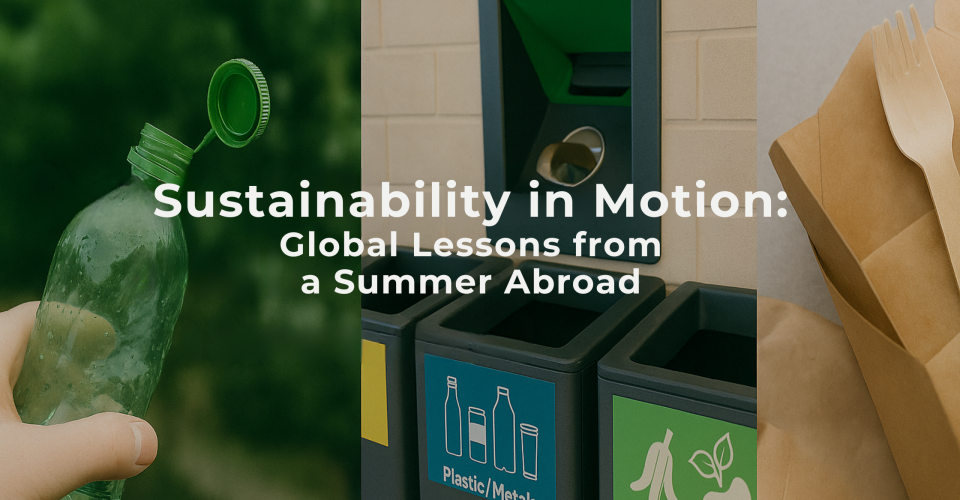During a summer spent traveling through Europe, I observed a quiet but powerful theme woven into daily life: sustainability. From train stations and tourist hubs to small cafés in the countryside, environmentally conscious practices weren’t just visible—they were expected. They weren’t marketed with bold claims or flashy campaigns; they were simply part of how things operated.
As the U.S. continues shaping its own sustainability path, these international experiences highlight how policy, culture, and business practices can come together to create change. They offer both inspiration and practical lessons we can localize and apply.
Small Packaging Changes, Big Environmental Wins
One of the first things that stood out during my travels? Tethered bottle caps.
In 2024, the EU introduced a regulation requiring that plastic bottle caps stay attached after opening. It might seem like a small inconvenience, but the reasoning is sound: caps are one of the most frequently littered plastic items. When separated from bottles, they often end up in landfills, waterways, or the ocean.
By keeping caps connected, the entire bottle is more likely to remain intact through disposal and recycling—making recovery easier for waste systems and reducing plastic leakage into the environment.
✅ Lesson: Small, thoughtful design changes—especially when backed by regulation—can have outsized impact.
Compostables as the New Standard
In Europe, particularly across restaurants and cafés, wooden cutlery is now the norm. This shift stems from the EU ban on single-use plastic utensils and straws. But what’s powerful is how seamlessly businesses have adopted the change.
Natural-material cutlery—like wood or plant fiber—now appears not just in eco-conscious eateries, but across a wide range of venues, including fast casual and high-end restaurants. Customers don’t question it; it’s simply the new baseline.
✅ Lesson: When sustainable alternatives are integrated as the default, adoption becomes effortless. The key is preserving convenience while raising the standard.
Germany’s Pfand System: Circularity That Works
Having lived in Germany for much of my life, I’m familiar with the Pfand system—a deposit-return model that’s embedded in the culture. With every purchase of a drink in a plastic bottle, aluminum can, or glass container, customers pay a small deposit. When the container is returned—usually to a reverse vending machine or grocery store—the deposit is refunded.
This system is so widely embraced that Germany boasts one of the world’s highest return rates for beverage containers: up to 98%. The infrastructure is intuitive and easy to use, and the refund incentive keeps participation high.
✅ Lesson: Circular systems thrive when they’re accessible, incentivized, and consistently implemented across a region.
Waste Sorting: Built into Daily Life
Another common thread across Europe is the level of care and structure around waste sorting. Households, hotels, and public areas all follow a multi-bin system where materials are separated with precision.
Typical categories include:
- Paper and cardboard
- Plastics and metals
- Glass (often sorted by color)
- Organic waste and compostables
- Hazardous materials (e.g., batteries, electronics)
This kind of infrastructure is supported by clear signage, public education, and normalized behaviors. What might seem overwhelming to visitors is second nature to locals.
✅ Lesson: Better sorting at the source leads to better recovery outcomes. In the U.S., early signs of this are emerging through bin redesign, staff training, and signage updates in commercial settings.
Country Spotlights: Circular Practices in Action
Throughout the continent, local governments and foodservice businesses are embracing circularity—not just through products, but through systems and incentives. Here are a few standout examples:
- France & Italy have enforced full bans on plastic plates and cutlery, resulting in widespread adoption of reusable dishware and compostable packaging.
- The Netherlands introduced mandatory fees on single-use containers, leading many cafés to join reusable cup or container programs.
- The UK & Ireland have normalized bring-your-own-cup campaigns, with retailers encouraging participation through discounts and clear compostable labeling.
- Nordic countries are promoting reuse through pilot programs, public education, and discounts for customers who bring their own containers. Some regions are even experimenting with public washing stations for shared containers.
These actions show that when businesses, policymakers, and customers align, real change happens.
U.S. Momentum: Progress in Motion
While our systems and regulations may differ, the U.S. is seeing growing momentum toward circularity.
Compostable packaging pilots are gaining traction. Startups are rethinking packaging through smart labeling and localized composting. Reuse systems, once niche, are being tested by businesses looking to reduce operational waste and respond to growing customer interest.
Consumers are more aware than ever. They’re demanding transparency, sustainable options, and brands that align with their values. The energy is real—and it’s growing.
Four Actions You Can Take Today
No matter your role—whether you’re in procurement, operations, foodservice, or simply sustainability-minded—there are simple, effective ways to begin or deepen your impact:
🔹 Switch to compostable or reusable cutlery. Wood, bamboo, and plant-based options are increasingly available.
🔹 Pilot a reuse or deposit-return system. Even small-scale efforts build customer engagement and loyalty.
🔹 Improve your sorting infrastructure. Use clearly labeled bins and train staff to support better waste diversion.
🔹 Share your sustainability story. Today’s customers want to support businesses that reflect their values.
Reflecting on What’s Possible
What stood out most from this summer’s travels wasn’t flashy campaigns—it was the quiet normalization of sustainable behavior. Europe’s example shows us what can happen when policy, business, and culture work in harmony.
The opportunity for U.S. businesses isn’t to copy these systems exactly, but to draw inspiration and adapt locally. Our path forward will look different, but the shared values of circularity, transparency, and stewardship apply everywhere.
Partnering for Practical Progress
At Direct Source Procurement, we help foodservice and hospitality teams find the right packaging solutions—whether compostable, reusable, or somewhere in between. Our goal is to support your sustainability journey without compromise, balancing performance, cost, and environmental impact.
Whether you’re looking to begin your shift or scale an existing program, we’re here to help.
📎 Read and share the original version of this article on LinkedIn Newsletter.
📲 Connect with us: Instagram | Facebook | LinkedIn

